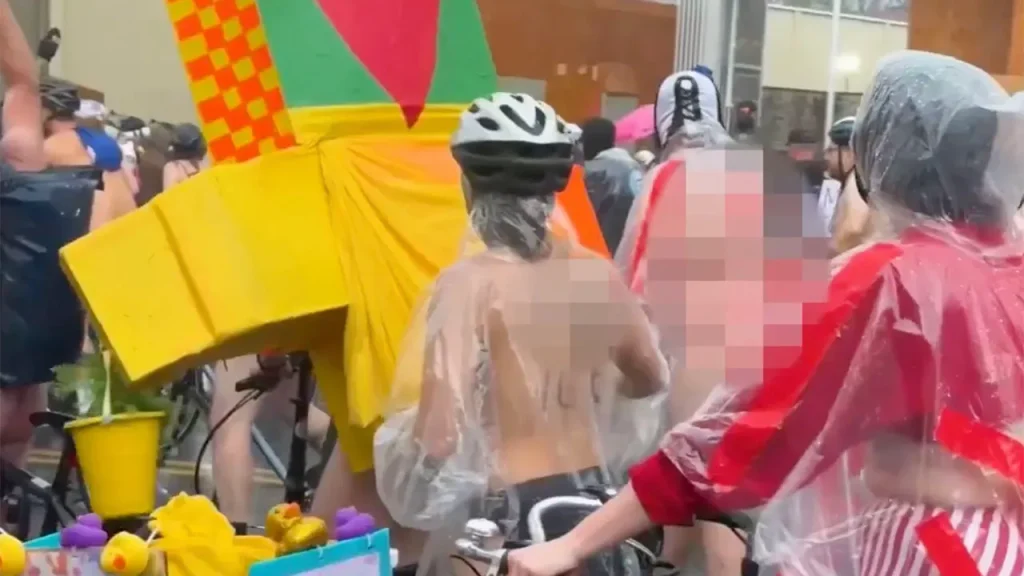Nude Cyclists in Portland: A Different Approach to ICE Protests
In a striking departure from typical anti-immigration protests, Portland witnessed an unusual demonstration when a group of naked cyclists staged a protest outside the city’s Immigration and Customs Enforcement (ICE) detention facility. On a rainy Sunday afternoon, these bare-bodied protesters pedaled up to the federal building, playing loud music through speakers while voicing their opposition to immigration enforcement policies. Some cyclists had painted slogans on their bodies including “No Kings” and “No human being is illegal,” making their political statements through both words and their unconventional demonstration style. As they circled the facility, some protesters shouted anti-ICE slogans and made offensive gestures toward the federal agents who watched from the rooftop, with a few officers apparently recording the scene on their phones. The federal officers who had been positioned as a street barricade retreated several yards, creating space for the nude cyclists to continue their demonstration unimpeded.
This naked bicycle protest represents a dramatic contrast to Portland’s more familiar anti-ICE demonstrations, which have frequently escalated into violent confrontations. The city has experienced months of clashes between protesters and federal officers, with incidents involving fireworks, smoke grenades, rocks, and property damage. In one particularly alarming incident this past June, protesters broke glass and forcibly entered the ICE facility, while a September demonstration featured protesters rolling a guillotine into the street, resulting in injuries to four federal officers. Unlike these more violent encounters, the nude cycling protest featured none of the black-clad Antifa members who typically participate in such demonstrations and who often conceal their identities with full-coverage clothing. The peaceful, if provocative, nature of the bicycle demonstration offered a temporary respite from the destructive pattern that has characterized Portland’s protest landscape in recent months.
Online reactions to the nude protest varied widely, reflecting the polarized nature of current political discourse. Conservative commentators expressed outrage, with some like Robby Starbuck condemning the public nudity as inappropriate, especially given the possibility that children might witness it. “If you want to strut around naked in public, where kids can see you, then I see you as a mentally ill pedophile who belongs in jail,” wrote Starbuck, adding that “No sane state allows this.” Others approached the demonstration with mockery rather than anger. Andrew Kolvet of Turning Point USA joked that the display might actually discourage immigration, writing, “I have a feeling a bunch of illegals saw this and just threw up their hands and self-deported rather than be subjected to whatever this is.” Podcaster Kyle Becker sarcastically referred to the cyclists as “The Antifa ‘cavalry.'” These varied responses highlight how even unusual protest tactics immediately become absorbed into existing political narratives and interpreted through partisan lenses.
The ongoing tensions in Portland have created a complex situation for local law enforcement, who have been caught between federal authorities and protesters. A Portland Police Bureau sergeant, Andrew Braun, appeared to place some blame on counter-protesters who document the demonstrations, suggesting in an email that they “constantly return and antagonize the protesters until they are assaulted or pepper sprayed.” Braun described these counter-protesters as “a chronic source of police and medical calls at ICE,” implying that their presence contributes to escalating tensions. This perspective emerged as part of a lawsuit the city filed against then-President Donald Trump, revealing internal police communications about the ongoing protest situation. The Portland Police Chief has reportedly been promoting a “crowd support” approach to managing the demonstrations, though the effectiveness of this strategy remains unclear given the continued violence at the ICE facility.
The Portland protests highlight the deeply contested nature of immigration enforcement in the United States and the various forms of resistance that have emerged in response to federal policies. Immigration has become one of the most divisive issues in American politics, with ICE facilities becoming focal points for demonstrations across the country. Portland’s particularly active protest movement has maintained pressure on federal immigration authorities through both conventional demonstrations and more creative tactics like the nude bicycle protest. While some demonstrations have caused property damage and resulted in injuries, others have sought to make political statements through non-violent, if provocative, means. The diverse approaches reflect the range of perspectives within the broader movement opposing current immigration enforcement practices, from those willing to engage in property destruction to those using their bodies as instruments of peaceful protest.
As Portland continues to navigate these tensions, the nude bicycle demonstration represents just one moment in an ongoing struggle over immigration policy, protest tactics, and the relationship between federal authorities and local communities. The unusual protest garnered media attention precisely because it departed from the violent pattern that has characterized many anti-ICE demonstrations in the city. Whether rolling up on bicycles or rolling out guillotines, Portland’s protesters have made clear their opposition to current immigration enforcement practices. Meanwhile, federal agents continue to defend facilities that they view as necessary for implementing national immigration policies. In this highly charged atmosphere, even a peaceful protest by naked cyclists becomes a political flashpoint, drawing both ridicule and outrage from observers across the political spectrum. As Portland moves forward, the city’s residents, police, and federal authorities will continue to negotiate these complex dynamics in a community that has become a prominent battleground in America’s immigration debate.











